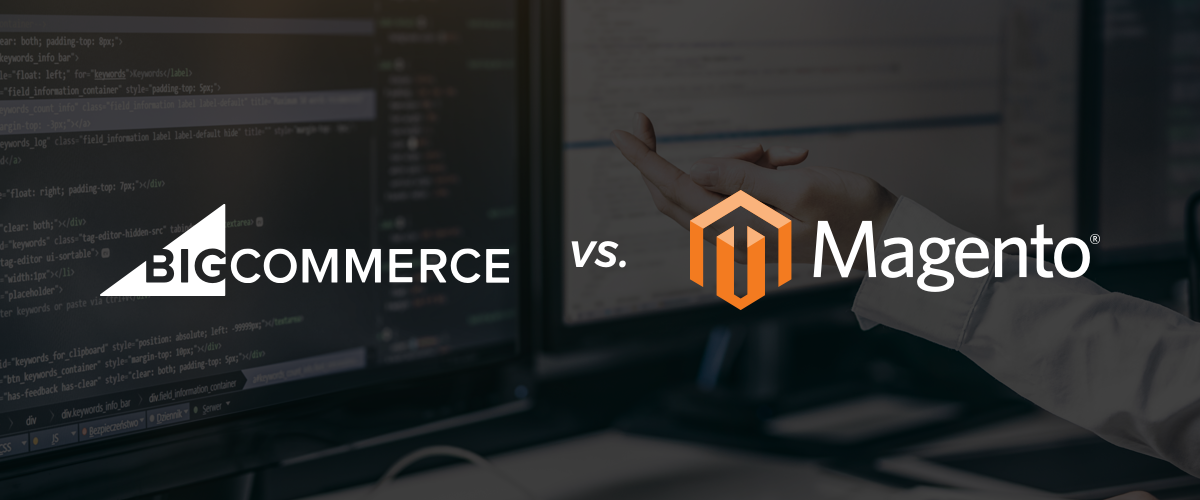Let’s Talk.
Start with a conversation. From there, we can build a plan.

When comparing Magento vs. BigCommerce, one has to examine both eCommerce platforms’ prices, timeframes, customization capabilities, features, ease-of-use, and many other aspects. Let this comparison post be your guide.
Top Three Pros and Cons for Both
Magento pros:
Magento cons:
BigCommerce pros:
BigCommerce cons:
Timeline for Starting a Magento vs. BigCommerce Shop
How long does it take to build a Magento site? It can take just two weeks to get a Magento shop up and running, or much longer depending on the customization and add-ons you desire.
How long does it take to build a BigCommerce site? It can take just 15 minutes to launch a BigCommerce store, but the store will be in its most basic form. It can take weeks, months, or longer to fully set up the site.
Shop Customization Capabilities: Magento vs. BigCommerce
Magento is all about customization. It uses an open-source coding system, which means merchants can completely customize their shops from the ground up. Magento has incredible flexibility to create unique and branded user experiences. It’s the world’s largest provider of customized extensions.
BigCommerce offers out-of-the-box themes or an advanced customization framework for new shops. There are more than 80 responsive design templates available (only seven are free). BigCommerce has a storefront editor that doesn’t require coding to change a site’s look, as well as a framework for customizing stores further using code libraries.
Price Comparison: Magento vs. BigCommerce Prices
Up-front costs: Magento Community for small to medium businesses is free to download and use. BigCommerce has a free 15-day trial, after which merchants can choose from monthly SaaS plans ranging from $29 to $249 per month.
Total cost of ownership: Magento’s prices can vary depending on the company itself, as well as the developers and third-party hosting sites chosen. Basic site costs can range from $20,000 to $42,000, while custom sites cost more. BigCommerce uses a pay-by-month SaaS model, and its total cost of ownership averages around $76,000 for the first year, and less for subsequent years.
Ease-of-Use: Front-End and Back-End
BigCommerce has a simpler back-end development process than Magento, but Magento offers plenty of developers and support options to make the creation process easier. Magento’s front-end customer experience is exceptional, with an extremely easy checkout process. BigCommerce’s front end is simple and easy for shoppers to browse, with cart-saving features and product reviews.
Top Features: Magento vs. BigCommerce
The top features of Magento include unparalleled shop customization, flexible pricing options, easy catalog management, multi-store capabilities, and order processing integration. Top features of BigCommerce include customizable store templates, marketing features, real-time inventory information, and detailed analytics.
Community Size and Support
Magento gives shop owners access to the largest eCommerce community in the world. More than 250,000 merchants actively use Magento. There are 150,000 developers and more than 300 solution partners connected to Magento, and 5,000-plus platform extensions available. BigCommerce boasts an active community forum for questions and discussions, as well as certified expert partners and a developer portal. Both BigCommerce and Magento offer 24/7 one-on-one support via phone, chat, and email.
Design Flexibility
Magento provides absolute design flexibility from the very start of the site through its open-source coding capabilities. If merchants don’t understand coding, there are thousands of developers ready to help. Templates are extremely flexible, allowing for 100% site customization. BigCommerce isn’t quite as flexible with its templates, and charges users $100-$200 for premium templates and add-ons.
Popularity of Magento vs. BigCommerce
Magento currently powers more than 250,000 online stores, including big names such as Nike, Ford, Samsung, and Coca Cola. BigCommerce powers more than 55,000 stores and sites, including Pandora and Toyota.
Mobile Capabilities
Both Magento and BigCommerce offer mobile-first designs and features at no additional cost. Both platforms’ mobile capabilities are automatic, taking no additional time to set up or implement.
Still interested in learning more about either platform? Reach out to the Magento managed services experts at Forix to hear more.
Start with a conversation. From there, we can build a plan.
